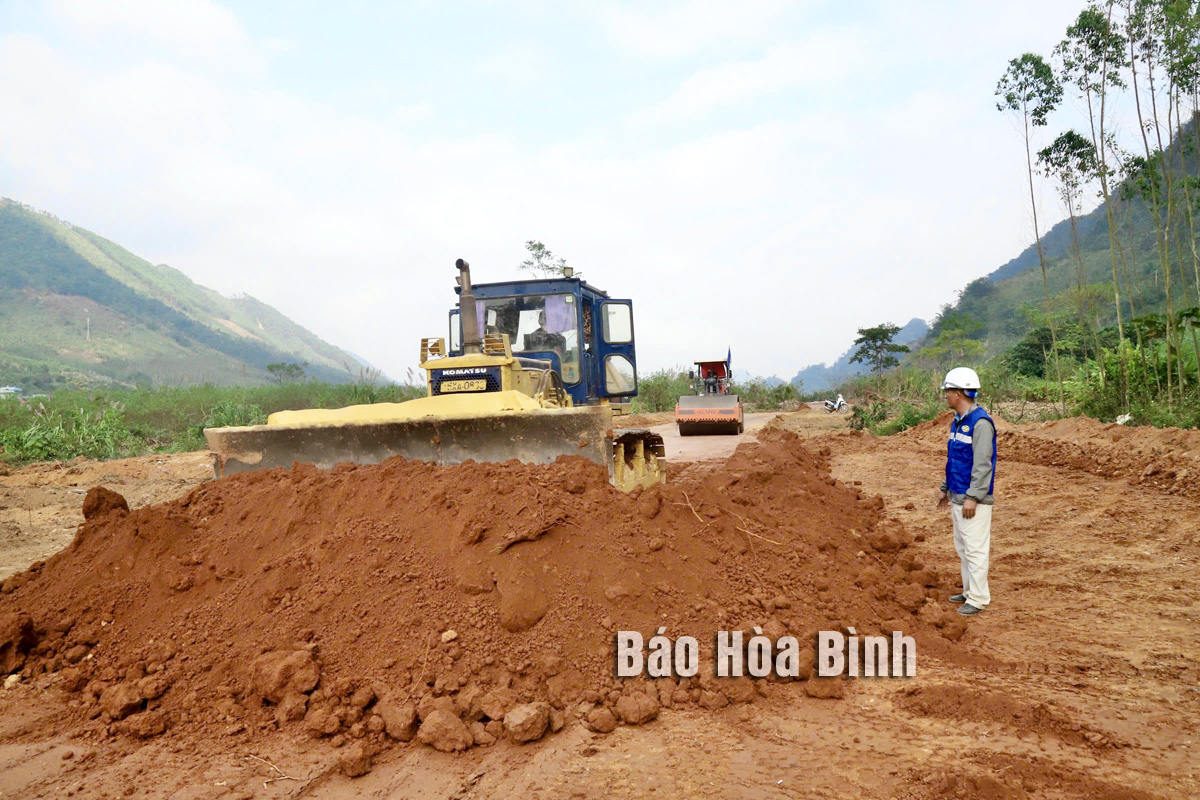


No success is easy, especially for a mountainous province like Hoa Binh, which still faces many difficulties. In the process of economic restructuring, the locality encounters various challenges, ranging from weak infrastructure, ineffective investment attraction, to barriers in awareness. However, it has taken effective solutions to overcome obstacles hindering economic development.

Construction on Hoa Binh - Moc Chau expressway, a key transportation project in Hoa Binh province, is being accelerated to enhance regional connectivity and promote socio-economic development.
Many barriers on the path of renewal
According to the province's master plan for the 2021-2030 period. with a vision to 2050, Hoa Binh aims to develop 16 industrial zones (IZs) and 38 industrial clusters (ICs) covering a total area of over 3,600 hectares. Currently, the provincial People's Committee has decided to establish five IZs, three of which are already operational, along with 16 ICs. The development of these zones and clusters has met the growth requirements, creating necessary infrastructure to attract investors and businesses, and contributing to increasing production capacity and accelerating socio-economic development. However, during the development and management of these zones and clusters, some issues remain, particularly in land compensation, land clearance, land recovery, and resettlement. Most of the zones and clusters lack social infrastructure planning such as workers' housing, kindergartens, and recreational areas, making it difficult to attract labourers.
In addition, transportation connectivity between localities within the province and between the province and the economic centres like Hanoi and the Red River Delta is not yet convenient, causing difficulties, especially in goods transportation, which affects investment decisions by businesses.
As a mountainous province with a low starting point, Hoa Binh also faces difficulties in investment capital and high-quality human resources. The local budget is limited, which makes infrastructure investment and support for businesses constrained. Although the number of businesses in the province has rapidly increased, 98% are small- and micro-sized enterprises. The number of large enterprises is still modest, which results in the economy's competitiveness being relatively low, said Ha Trung Nguyen, Vice Chairman of the provincial Business Association.
Turning challenges into development opportunities
Despite these challenges, Hoa Binh has not dragged its feet. Based on a clear identification of its limitations and the underlying causes, the province’s leaders have taken strong solutions to overcome them. First and foremost, the province places great importance on improving the investment and business environment to attract the maximum amount of social resources. The province clearly understands that supporting investors is one of its top priorities.
In recent years, it has made significant progress in the Provincial Competitiveness Index (PCI) and the Public Administration Reform Index (PAR Index). In 2023, it ranked 23rd out of the 63 provinces and cities in the PAR Index. Notably, it ranked 8th nationwide in terms of the satisfaction of citizens and businesses with administrative services.
According to Chu Van Thang, head of the provincial Industrial Zones Management Board, Hoa Binh has implemented different attractive investment policies and incentives. Notably, it offers the highest tax incentives in terms of corporate income tax and land lease fees for projects in priority sectors or in challenging areas. Investors in high-tech agriculture, supporting industries, community-based tourism, and other sectors receive partial funding for infrastructure construction and labor training.
Every year, the province organises large-scale investment promotion conferences, inviting potential businesses to explore opportunities. Thanks to these friendly and open policies, Hoa Binh has attracted a lot of projects that were previously considered unlikely, thus creating new resources for development.
Along with attracting investment, the synchronised development of infrastructure has been seen as a strategic breakthrough, with the province prioritising resources and seeking support from the central level to upgrade transportation and urban infrastructure, energy, and telecommunications.
Thanks to these decisive and comprehensive solutions, the local investment environment and infrastructure have significantly improved. Hoa Binh is gradually becoming a more attractive destination for investors. As of the end of 2024, the province had 735 active investment projects with a total registered capital of approximately 270 trillion VND (10.5 billion USD), including 697 domestic and 38 foreign direct investment (FDI) projects. These numbers reflect the province's positive development and investment attraction since the restructuring process began.
It is this determination and continuous effort that has helped Hoa Binh gradually overcome obstacles and turn challenges into development opportunities.